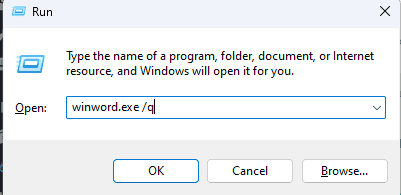Mastering Microsoft Word goes beyond creating and editing documents. Advanced users can use command line switches when launching Word to change its default behavior and streamline their workflow. These switches can automate tasks and provide more control while using Word. Using command line switches in Microsoft Word can customize your startup experience and automate tasks, saving you time and enhancing productivity.
While understanding and using command line switches may require some technical knowledge, anyone can learn to use them. Each switch performs a specific function, such as starting Word with a specific template, opening Word in Safe Mode, or speeding up startup. Understanding command line basics can set a user apart, revealing the more technical side of Microsoft Word. Don’t forget to explore the full list of available switches to further tailor Word to your specific needs.

Master Microsoft Word: Harness the Power of Command-Line Switches
What are Command-Line Switches?
Command-line switches are special codes you can add to the Microsoft Word startup command. These switches modify how Word starts up, allowing you to customize the experience and perform specific actions.
Why Use Command-Line Switches?
Command-line switches empower you to:
- Open Specific Documents or Templates: Launch Word with a particular document or template ready to go.
- Automate Tasks: Execute macros or scripts automatically upon startup.
- Control Startup Behavior: Disable add-ins or start Word in Safe Mode for troubleshooting.
- Customize the Interface: Open Word with specific settings or preferences.
Common Command-Line Switches for Word
| Switch | Description | Example |
|---|---|---|
/q | Start Word without the splash screen. | winword.exe /q |
/t <template_name> | Start Word with a new document based on the specified template. | winword.exe /t "MyTemplate.dotx" |
/f <file_name> | Start Word and open an existing document. | winword.exe /f "MyDocument.docx" |
/m | Start Word without running any AutoExec macros. | winword.exe /m |
/m <macro_name> | Start Word and run the specified macro. | winword.exe /m MyMacro |
/a | Start Word and prevent add-ins and global templates from loading. | winword.exe /a |
/safe | Start Word in Safe Mode (disables add-ins and customizations). | winword.exe /safe |
How to Use Command-Line Switches
- Find the Word executable: Locate the
winword.exefile on your computer. The default location is usuallyC:\Program Files\Microsoft Office\root\Office16(or a similar path depending on your Office version). - Open the Run dialog: Press
Win + Rto open the Run dialog. - Enter the command: Type
winword.exefollowed by the desired switch and any parameters (e.g.,winword.exe /t "MyTemplate.dotx"). - Press Enter: Word will launch with the specified switch applied.
Creating Shortcuts with Command-Line Switches
For frequently used switches, create a desktop shortcut:
- Right-click on your desktop: Select “New” > “Shortcut.”
- Enter the command: In the “Type the location of the item” field, enter the full path to
winword.exefollowed by the switch and any parameters (enclose file paths with spaces in quotes). - Name the shortcut: Give your shortcut a descriptive name and click “Finish.”
- Double-click the shortcut: Word will launch with the specified switch every time you use the shortcut.
Key Takeaways
- Command line switches enable advanced control over Microsoft Word.
- They provide efficiency and customization beyond the graphical user interface.
- Knowing these switches is valuable for troubleshooting and automating tasks.
Mastering Microsoft Word Through Command Line Switches
Mastering command line switches in Microsoft Word can streamline the application’s startup process, manage add-ins, and automate repetitive tasks efficiently.
Understanding Command Line Basics for Microsoft Word
To execute control over Microsoft Word via the command prompt, one must learn how to use winword.exe coupled with various switches. For example, to start Word and open a specific document, the command winword.exe /tC:\example.docx would be utilized, where /t is the command line switch that tells Word to open the template specified.
Advanced Command Line Techniques
Advanced users can utilize command line switches to perform complex tasks such as controlling macros and attaching add-ins. The switch /m opens Word and runs a specified macro, while /w opens a new Word window with a duplicate of the open document.
Practical Use Cases and Tips
Professionals may use switches to boost their workflow; for instance, /q starts Word with no startup screen. This is practical for reports that require a clean startup or when batch scripts need to open, save, and close documents in rapid succession.
Integrations and Sharing
Integrations, such as opening documents from SharePoint or linking with Outlook, can be facilitated through command line switches. One can use /n to create a new document that is a copy of the one specified, seamlessly sharing via network directories.
Troubleshooting and Support
For troubleshooting, /a initiates Word in safe mode, often bypassing plugin-related issues. If there’s a corrupted document or a problematic add-in, one might use /safe to repair the user interface or /r to restore Word to its default settings.







